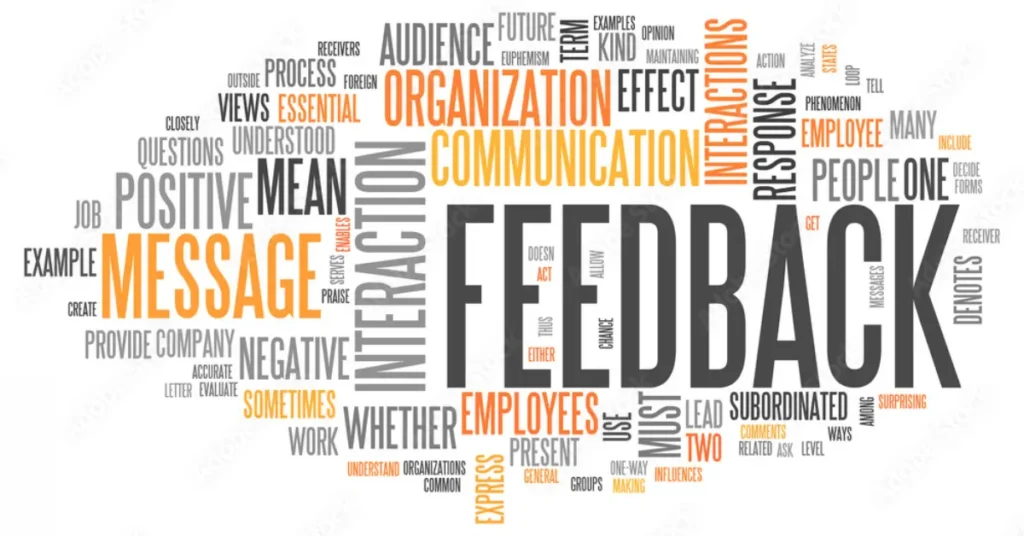Are you ready to unlock the true potential of your training programs? Crafting constructive and actionable feedback is essential for continuous improvement and growth. Dive into our guide on detailed training feedback sample answers to enhance your instructional effectiveness and empower your learners today!

Table of Contents
How To Write Feedback About Trainer

When writing feedback about a trainer, it’s crucial to recognize their critical role in facilitating learning and development within the organization. Excellent feedback should highlight the trainer’s communication and interpersonal skills, their ability to create engaging and effective training programs, and their thorough understanding of the subject matter. Recently, I’ve observed that well-prepared trainers who communicate clearly and address questions effectively make a significant impact. It’s also important to provide constructive and beneficial feedback that helps them refine their approach and improve their performance. In my experience, such detailed feedback not only supports the trainer’s growth but also enhances the training experience for employees and trainees alike.
20 Unique Training Feedback Sample Answers

Here are 20 unique training feedback sample answers designed to enhance learning and development. Use these examples to provide constructive and actionable feedback that drives continuous improvement.
Positive feedback:

Providing positive feedback involves acknowledging the trainer’s enthusiasm and dedication while highlighting their ability to make the subject matter engaging and easy to follow. Praise should focus on their use of real-world examples and interactive activities that help learners understand and apply concepts effectively. For instance, I’ve observed that trainers who incorporate such engaging elements often see higher success rates among participants. Their commitment to making training relevant and applicable greatly enhances the overall learning experience.
Constructive feedback:

Constructive feedback should address the thoroughness of the material and pace of delivery. If slides are cluttered or difficult to read, it’s helpful to simplify visuals to enhance effectiveness. Feedback should also be noted if the presentation felt slow or if the discussion and questions were not adequately addressed. In my experience, providing feedback on these areas helps trainers refine their approach and improve the overall speed and engagement of their sessions.
Negative feedback:

Negative feedback should address areas where the training was disappointing. For example, if the material was disorganized and did not follow a clear progression, this should be noted. Feedback may include if the trainer appeared unprepared or stumbled over their words, impacting the clarity and conciseness of the sessions. Suggesting that the trainer could better prepare and organize ideas could significantly enhance the effectiveness of the training. In my experience, highlighting these areas helps trainers address gaps and improve future performance.
Positive feedback:

Positive feedback should highlight the energy and enthusiasm that the trainer brings to the sessions. Commend their infectious dedication and the way they keep learners engaged with practical tips and insights. Acknowledge how these elements help apply the concepts effectively in work and contribute to overall success. From my experience, such feedback not only motivates trainers but also reinforces their commitment to delivering impactful training.
Constructive feedback:

Constructive feedback should address how the trainer can make their voice less monotone and vary their tone to avoid making the session difficult to stay engaged with. Suggest incorporating more storytelling and relevant examples to make the content more engaging and informative. In my experience, improving these aspects helps trainers better connect with participants and enhances the overall effectiveness of the training.
Negative feedback:

Negative feedback should be addressed when a training session feels unhelpful and unengaging, with a dry and uninspiring delivery. If visuals and activities are challenging or fail to focus on engaging the audience, this should be highlighted. Suggest improvements for more interactive elements to make the session more effective. In my experience, addressing these issues directly helps trainers adjust their approach and significantly enhance audience engagement and overall impact.
Positive feedback:

Positive feedback should commend the trainer for their fantastic presentation and enthusiasm, which makes the session both engaging and energetic. Highlight how their practical strategies and specific insights are relevant and effectively address needs. Praise their excellent skills in making the content apply directly to work, contributing to overall success. From my experience, recognizing these strengths not only boosts the trainer’s morale but also reinforces their commitment to delivering high-quality training.
Constructive feedback:

Constructive feedback should address the use of jargon and technical terms that may be unfamiliar to the audience. Suggest simplifying the language to make the content more accessible and ensuring that it covers a broad range of opportunities for discussion. Encourage the trainer to adjust their approach so that all participants can fully understand the material. In my experience, making such adjustments significantly improves engagement and the effectiveness of the training sessions.
Negative feedback:

Negative feedback should be pointed out when the presentation is unorganized and scattered, making it difficult for the audience to follow and understand the ideas. If the progression of content lacks a clear and concise structure, suggests that the trainer needs to structure their approach more effectively. In my experience, addressing these issues helps trainers create more coherent and engaging sessions, ultimately improving learner outcomes.
Positive feedback:

Positive feedback should emphasize how the trainer’s enthusiasm and energy are evident throughout the session, making the training both engaging and impactful. Highlight their dedication to incorporating practical strategies and real-world examples, which help learners grasp concepts effectively. From my experience, recognizing these strengths not only motivates the trainer but also enhances the overall training experience by making it more relevant and actionable.
Sarcastic feedback:

Sarcastic feedback might describe the presentation as spectacularly monotonous, where the voice delivery was so sleep-inducing that it could turn even the most riveting topic into an hours-long edge-of-your-seat experience of boredom. Such feedback, though exaggerated, highlights the need for a more dynamic approach to keep participants engaged. From my experience, it’s crucial to address these issues constructively to ensure future sessions are both engaging and effective.
Blunt feedback:

Blunt feedback might simply state that the presentation was dry and lacking in engaging content, with material that failed to capture interest or address focused needs. It’s noted that the trainer could improve their skills to avoid the phone-inducing monotony. This straightforward critique emphasizes the need for a more dynamic and interactive approach. Drawing from my experience, clear and actionable feedback is vital for making impactful changes and enhancing future sessions.
Passive-aggressive feedback:

Passive-aggressive feedback might suggest that while the training was informative and covered basic concepts, it fell short of being engaging or interactive. The relevant activities were noted but did not sufficiently keep the audience engaged. This feedback subtly hints at areas needing improvement without directly confronting the issues. From my experience, addressing these underlying concerns openly can transform subtle hints into clear, actionable insights that genuinely enhance training effectiveness.
Over-the-top positive feedback:

The training was nothing short of incredible, offering life-changing insights that felt like a masterclass in how to conquer the world. The enthusiasm was contagious, making each moment of the session feel like a thrilling leap into the next level of excellence. Every detail was impeccable, creating an atmosphere where the material seemed to elevate beyond expectations. Drawing from my experience, while such over-the-top feedback highlights exceptional aspects, balancing it with realistic observations ensures continuous improvement and sustained success.
Empathetic feedback:

I truly appreciate the effort put into the training, though it sometimes felt flat and dry. The challenging content might have made it difficult for some to stay engaged. Enhancing the interactive elements and incorporating more activities and visuals could help address these issues and make the sessions more dynamic. From my experience, focusing on making content more engaging can significantly boost overall effectiveness and participant satisfaction.
Diplomatic feedback:

The training was informative and provided valuable insights, but there is room for improvement in the presentation of the content. Enhancing delivery and incorporating more interactive discussion segments could elevate the overall effectiveness. Addressing questions more thoroughly would also help in refining the skills being taught. In my experience, striking a balance between content depth and engagement is key to a successful training session.
Complimentary feedback:

The training session was highly informative and demonstrated considerable effort in creating and explaining the content. The trainer’s ability to break down complex concepts made them easy to understand, reflecting their deep knowledge and hard work. This approach not only enhanced comprehension but also made learning engaging. From my experience, the effectiveness of training is greatly amplified when intricate topics are made accessible through thoughtful presentation.
Short and sweet feedback:

Thanks for the training; it was informative and covered everything we needed. From my experience, a concise yet effective training session often leaves the most impact, making it easier to retain and apply the information.
Detailed feedback:

The detailed approach to the material was appreciated, with a thoroughness that ensured all relevant points were covered. However, the pace was a bit slow, which made it challenging for some participants to stay fully engaged. Providing more examples and adjusting the speed could enhance the delivery and make the content more applicable. In my experience, balancing thoroughness with an appropriate pace is crucial for maintaining participant interest and ensuring that the information is both engaging and useful.
Positive and encouraging feedback:

The enthusiasm displayed during the training was fantastic, making the session highly engaging and accessible to all participants. While there is always room for improvement, the overall presentation was impressive, setting a positive tone for the next session. I’ve found that a positive and enthusiastic delivery can significantly boost participant morale and motivation, ensuring that future sessions continue to build on this fantastic momentum.
Conclusion
Are you aiming to refine your training programs? Effective feedback is key to this process, helping to identify areas for improvement and recognize successes. Explore our comprehensive guide on detailed training feedback sample answers to boost your instructional strategies and empower your trainees effectively!
FAQS
How do you write good feedback for training?
“Thank you for a great course. Great presentation style with lots of opportunities to ask questions and talk about real-life examples which all made for a really enjoyable and informative course.” “This has more than met my expectations.” “A wonderfully practical course – both personally and professionally.
What are some examples of positive feedback for a course?
Course feedback
“It is a top-quality course. Keep going, we need this type of course to improve our studies. Excellent. Thank you!!”
“Well done. Good course. Excellent tutor”
How do I review a course?
Did you enjoy the course?
What was good and/or bad about it?
Did the course improve your knowledge of the subject?
Write about the course, not unrelated topics.
Avoid offensive language or comments.
You may like to read over your review before posting to check for typos or unclear statements.
How do you write positive feedback?
Be Specific: Clearly articulate what actions or behaviors impressed you, providing specific examples.

Wonderful!